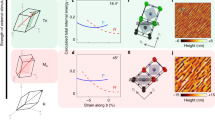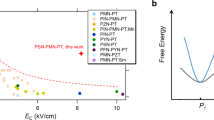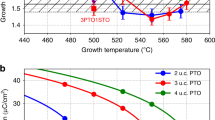Abstract
Ferroelectric crystals are characterized by their asymmetric or polar structures. In an electric field, ions undergo asymmetric displacement and result in a small change in crystal dimension, which is proportional to the applied field1,2. Such electric-field-induced strain (or piezoelectricity) has found extensive applications in actuators and sensors2. However, the effect is generally very small and thus limits its usefulness. Here I show that with a different mechanism, an aged BaTiO3 single crystal can generate a large recoverable nonlinear strain of 0.75% at a low field of 200 V mm−1. At the same field this value is about 40 times higher than piezoelectric Pb(Zr, Ti)O3 (PZT) ceramics and more than 10 times higher than the high-strain Pb(Zn1/3Nb2/3)O3–PbTiO3 (PZN-PT) single crystals3,4,5. This large electro-strain stems from an unusual reversible domain switching (most importantly the switching of non-180° domains) in which the restoring force is provided by a general symmetry-conforming property of point defects. This mechanism provides a general method to achieve large electro-strain effect in a wide range of ferroelectric systems and the effect may lead to novel applications in ultra-large stroke and nonlinear actuators.
This is a preview of subscription content, access via your institution
Access options
Subscribe to this journal
Receive 12 print issues and online access
$259.00 per year
only $21.58 per issue
Buy this article
- Purchase on Springer Link
- Instant access to full article PDF
Prices may be subject to local taxes which are calculated during checkout




Similar content being viewed by others
References
Lines, M.E. & Glass, A.M. Principles and Applications of Ferroelectrics and Related Materials (Oxford Univ. Press, Oxford, 1979).
Uchino, K. Piezoelectric Actuators and Ultrasonic Motors (Kluwer Academic, Boston, 1996).
Park, S.E. & Shrout, T.R. Ultrahigh strain and piezoelectric behaviour in relaxor based ferroelectric single crystal. J. Appl. Phys. 82, 1804–1811 (1997).
Service, R.F. Shape-changing crystals get shifter. Science 275, 1878 (1997).
Fu, H. & Cohen, R.E. Polarization rotation mechanism for ultrahigh electromechanical response in single-crystal piezoelectrics. Nature 403, 281–283 (2003).
Cohen, R.E. Origin of ferroelectricity in oxide ferroelectrics and the difference in ferroelectric behavior of BaTiO3 and PbTiO3 . Nature 358, 136–138 (1992).
Park, S.E., Wada, S., Cross, L.E. & Shrout, T.R. Crystallographically engineered BaTiO3 single crystals for high-performance piezoelectrics. J. Appl. Phys. 86, 2746–2750 (1999).
Burcsu, E., Ravichandran, G. & Bhattacharya, K. Large strain electrostrictive actuation in barium titanate. Appl. Phys. Lett. 77, 1698–1700 (2000).
Ren, X. & Otsuka, K. Origin of rubber-like behaviour in metal alloys. Nature, 389, 579–582 (1997).
Ren, X. & Otsuka, K. Universal symmetry property of point defects in crystals. Phys. Rev. Lett. 85, 1016–1019 (2000).
Wayman, C.M. Shape memory and related phenomena. Prog. Mater. Sci. 36, 203–224 (1992).
Christian, J.W. Deformation by moving interface. Metall. Trans. A 13, 509–538 (1982).
Tsunekawa, S., Suezawa, M. & Takei, H. New type ferroelastic behaviour of NdNbO4 crystals. Phys. Stat. Sol. A 40, 437–446 (1977).
Ren, X. & Otsuka, K. The interaction of point defects with the martensitic transformation: A prototype of exotic multiscale phenomena. Mater. Res. Soc. Bull. 27, 115–120 (2002).
Warren, W.L. et al. Defect-dipole alignment and tetragonal strain in ferroelectrics, J. Appl. Phys. 79, 9250–9257 (1996).
Warren, W.L., Dimos, D., Pike, G.E., Vanheusden, K. & Ramesh, R. Alignment of defect dipoles in polycrystalline ferroelectrics. Appl. Phys. Lett. 67, 1689–1691 (1995).
Lohkamper, R., Neumann, H. & Arlt, G. Internal bias in acceptor-doped BaTiO3 ceramics: Numerical evaluation of increase and decrease. J. Appl. Phys. 68, 4220–4225 (1990).
Robels, U. & Arlt, G. Domain wall clamping in ferroelectrics by orientation of defects, J. Appl. Phys. 73, 3454–3460 (1993).
Chynoweth, A.G. Radiation damage effects in ferroelectric Triglycine sulfate. Phys. Rev. 113, 159 (1959).
Keve, E.T., Bye, K.L., Whipps, P.W. & Annis, A.D. Structural inhibition of ferroelectric switiching in triglycine sulfate. Ferroelectrics 3, 39–48 (1971).
Lambeck, P.V. & Jonker, G.H. The nature of domain stabilization in ferroelectric pervoskites. J. Phys. Chem. Solids 47, 453–461 (1986).
Acknowledgements
The author thanks H.S. Luo for providing single crystal samples, D.Z. Sun, K. Otsuka, T. Suzuki, K. Nakamura, L.X. Zhang, W. Chen for helpful discussions, and K. Nishida for EPMA chemical analysis of the samples. This work was supported by Sakigake-21 of JST and a special fund for Cheungkong Professorship and National Natural Science Foundation of China.
Author information
Authors and Affiliations
Ethics declarations
Competing interests
The author declares no competing financial interests.
Supplementary information
Supplementary Information, Fig. S1
Supplementary Information, Fig. S2 (PDF 507 kb)
Rights and permissions
About this article
Cite this article
Ren, X. Large electric-field-induced strain in ferroelectric crystals by point-defect-mediated reversible domain switching. Nature Mater 3, 91–94 (2004). https://doi.org/10.1038/nmat1051
Received:
Accepted:
Published:
Issue Date:
DOI: https://doi.org/10.1038/nmat1051
This article is cited by
-
Contribution of irreversible non-180° domain to performance for multiphase coexisted potassium sodium niobate ceramics
Nature Communications (2024)
-
A review on piezoelectric ceramics and nanostructures: fundamentals and fabrications
Journal of the Australian Ceramic Society (2024)
-
Extended planar defects of oxygen vacancies in ferroelectric \(\hbox {BaTiO}_3\) and impact on ferroelectricity
Scientific Reports (2023)
-
Shape-memory effect in twisted ferroic nanocomposites
Nature Communications (2023)
-
Point-defect-driven flattened polar phonon bands in fluorite ferroelectrics
npj Computational Materials (2023)



